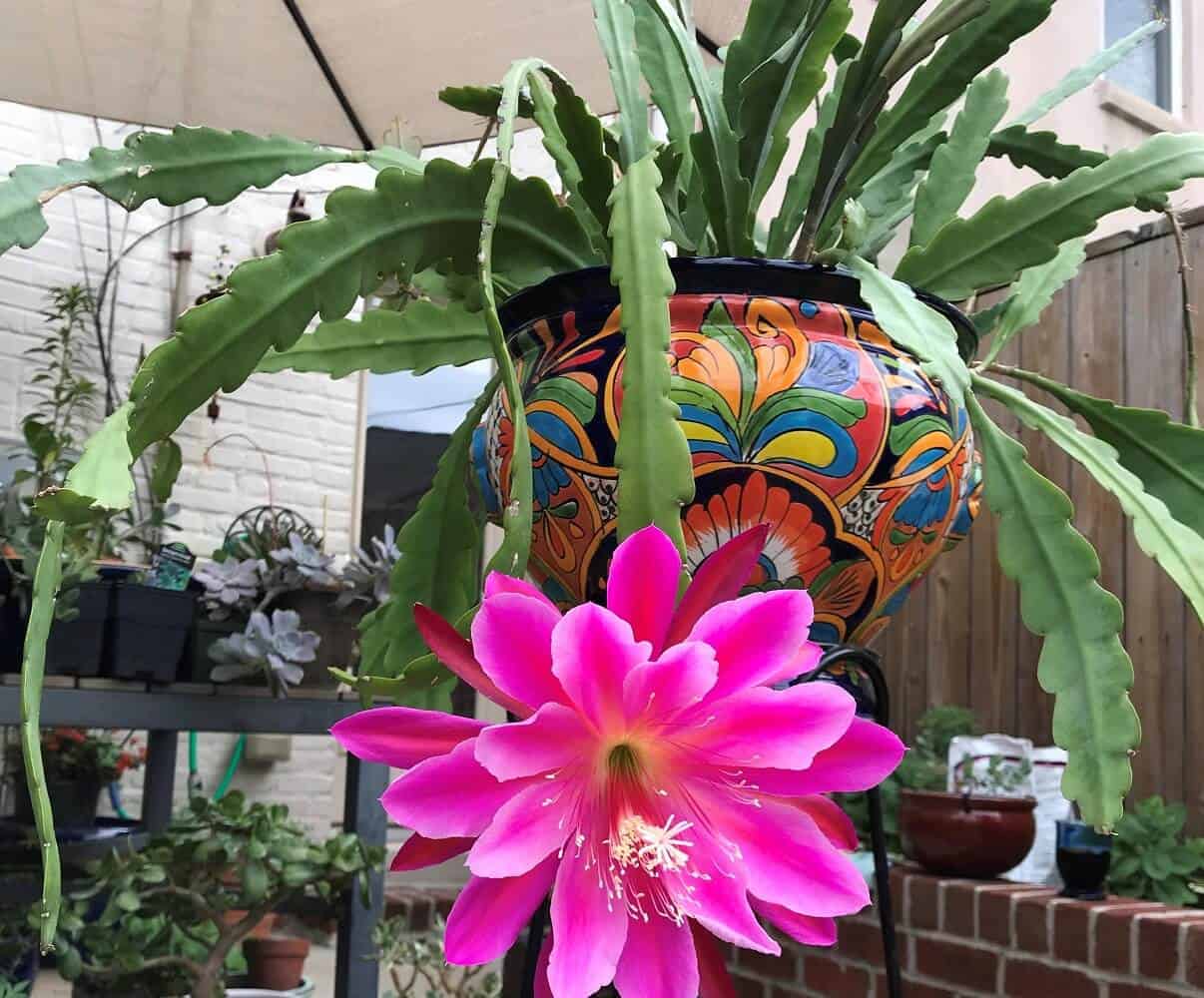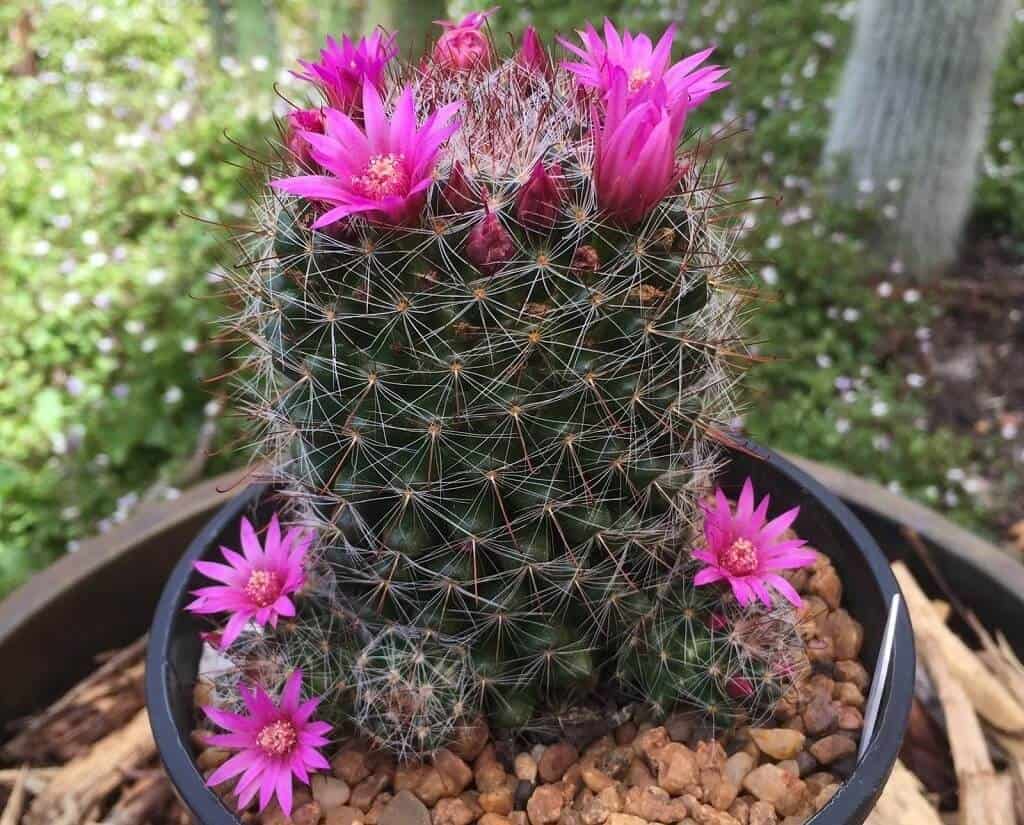While most succulents don’t have a problem producing and keeping beautiful their flowers, some are notorious when it comes to dropping those flowers. This post covers a list of easy flowering succulents to plant in your house or office and get to enjoy their showy blooms.
Given the right conditions, almost all the succulent plants will bear flowers. But some require more specialized care and attention to bloom than others. This group is what most green thumbs term as difficult or finicky succulents to deal with.
However, in today’s post, we’re going to list some of the easiest flowering succulents with low maintenance and cultural requirements.
Let’s dive in:
List of Easy Flowering Succulents to Grow Indoors
1. Schlumbergera Cacti

Christmas cacti, also botanically known as (Schlumbergera x buckleyi), are often great choices for hanging baskets - thanks to their pendulous trailing stems. When in full bloom, you can gift them to your loved ones or use them for decorating your home especially the interiors.
Other holiday cacti to add to your wish list include; the Thanksgiving cactus (Schlumbergera truncate), which is the most common, and the Easter cactus (Schlumbergera gaertneri).
2. Jade Plant (Crassula ovata)

Jade plants are both trees and succulents with the ability to purify the air in your home. Making them one of the most sought-after large indoor plants with beautiful showy blooms.
Besides, they’re drought-tolerant plants that you can easily grow in your garden or pots. Just keep the soil around your jade plant moist. Only watering when the soil is very dry to the touch.
Jade plants can adapt to different light conditions hence you can place them anywhere in your home. For good performance of your plants, use a fast-draining soil/ potting mix as these drought-tolerant plants hate sitting in water.
3. Orchid Cactus (Epiphyllum)
Orchid cacti, also known as Epiphyllum, have natural growth cycles during spring and fall. After flowering, the plants appear a little droopy. When this happens, do not increase watering more than usual to avoid root rots.
Keep in mind that for Epiphyllum to bloom well, they have to be root bound inside the container. This means their roots must fill the container before they will produce blossoms. Practically speaking, if the plants are in a 4-inch pot they will flower faster than if grown in an 8-inch pot.
Usually, flowering begins in late April (white and yellows), May (pink and reds), June, and July (deep reds and purples). For more information and growing requirements, check out this article – Growing Orchid Cactus (Epiphyllums)
4. Florist Kalanchoe (Kalanchoe blossfeldiana)

Kalanchoe is one of the most popular flowering succulents typically available for sale during the late winter and spring months. It is a durable flowering potted plant requiring very little maintenance in the home or office.
With good care, kalanchoes may be grown to rebloom the next season.
After flowering, shift the plant to a slightly larger pot. Kalanchoes are succulents that grow best in well-drained and well-aerated potting soil, such as 60% peat moss and 40% perlite. Cut back tall growth and old flower stems.
Keep well-watered in a sunny, warm window.
5. Stonecrop (Sedum spp)
Stonecrop, also known as Creeping Sedum is an easy flowering succulent plant with low maintenance and cultural requirements. The Creeping Sedum is a low-growing perennial and produces flowers above the base foliage that attracts butterflies and bees to your garden – if grown outdoor.
It is also resistant to drought hence requires little or no supplemental water even in the driest conditions. The plant is a great landscape ground cover.
6. Living Stone Plants (Lithops)

Living Stone Plants, also commonly known as Lithops are small, interesting plants native to southern Africa that are relatively easy to grow indoors. Most Living Stone plants flower during autumn and early winter, producing daisy-like yellow, pale orange, or white flowers with many petals.
The flowers open in the afternoon of sunny days and close again in the late afternoon. The flowers emerge from the fissure between the leaves. Some variety types have flowers that are scented.
Because they thrive in low humidity, they need infrequent watering and care. Living stone plants are popular novelty houseplants - with their small size, slow, and compact growth which don’t take up much room.
Here’s a detailed guide on Lithops origin and cultivation
7. Crown of Thorns (Euphorbia milii)

If you need a unique flowering succulent plant for your garden, or as a flowering houseplant - the crown of thorns plant is the best choice.
Classified as a succulent, crown of thorns has thick fleshy leaves and stems adapted for water storage. One of the many reasons that make this plant such a great choice for warmer areas since it's heat tolerant.
Crown of thorns doesn’t mind drying out so, it makes a good drought-resistant plant for gardens and pots – learn more about the best pot planters you can use.
8. Pincushion Cactus (Mammillaria)
Pincushion cacti are small, squat plants. They are native to the warmer regions of the United States. While you can safely grow this tiny cactus indoors, it can also tolerate some chilling temperatures if grown outside.
If you provide the plant with optimum heat and water conditions, the pincushion cactus will reward you with amazing flowers in spring. Enhance the chance of blooming by holding off watering until several weeks into spring.
Caution: Pincushion cactus is covered with very sharp white spines. Because of this prickly nature, make sure you handle the plant with thick and thornproof garden gloves.
9. Marble Buttons (Conophytum calculus)
Also known as the Living Pebbles plant, Conophytum calculus is a marble-like shaped plant with leaves that fuse to form a unique spherical dome that possesses a smooth, chalky and hairless texture.
Marble Buttons begin to produce charming flowers usually in autumn. The flowers range from yellow to golden to dark orange nocturnal with an intoxicating clove scent.
10. Peanut Cactus (Echinopsis chamaecereus)

The Peanut cactus is most suited to container growing because it is a small, low-growing cactus that tends to get lost in the garden. It grows well in zones 10 through 12 where the plant is adorned with large and bright orange flowers. Flowering begins in spring and summer.
For the best results, Peanut cactus needs a well-draining potting mix. Water the plant thoroughly until water comes through the pot's holes and let the soil dry at least halfway down the pot before watering again.
11. Echeveria ‘Afterglow’
Echeveria ‘Afterglow’ is one of the most attractive flowering succulents which is easy to care for and belongs to the Crassulaceae family.
The plant is a hybrid by Don Worth of San Francisco, California. He crossed two other Echeveria plant varieties – (seed parent) Echeveria cante (White Cloud Echeveria) and the (pollen parent) “Mexican Hen” Echeveria shaviana.
The flowers are typically a pinkish-lavender color with bright edges, giving it an ethereal quality. You may also notice smaller orange-red flowers appearing below the foliage. Here’s a great article on Echeveria Afterglow care by Plant Care Today.
12. Rock Purslane (Calandrinia grandiflora)
The Rock Purselane is a small super hardy succulent with thick blue-green foliage and gorgeous tall pink blossoms. The plants grow easily, fast, and look pretty stunning when they are in full bloom.
To get the best results with Rock Purslane and vigorous blooms, you need to expose them to full sun. The less of the light, the fewer blooms you’ll get.
13. Hummingbird Yucca (Hesperaloe parviflora)
Hummingbird Yucca is also commonly known as the Red Yucca plus a bunch of other names. In appearance, this agave family succulent plant is more like ornamental grass, but it’s a better alternative to the grass.
This is because of its beautiful flower stalks and flowers and low maintenance requirements. It grows best outside in hot climates because it is extremely drought and heat-tolerant. You can also grow it indoors especially if you’ve got access to a sunny window.
14. Common Houseleek (Sempervivum tectorum)
The common houseleek, also known as old-man-and-woman or hen-and-chicks, has given rise to several cultivated varieties of horticultural interest. Cobweb houseleek (S. arachnoideum), with leaf tips connected by web-like strands, has also yielded many desirable varieties.
Common Houseleek is useful in garden borders, rock gardens and is attractive in window pots indoors too!
15. Spiral Aloe (Aloe polyphylla)
Spiral Aloe is a species of flowering succulents in the Aloe family with a distinct spiraling form. This plant is highly desired and usually short-lived in cultivation. The flowers are salmon-pink to red, rarely yellow, on branched inflorescences.
The only drawback is that this aloe is not a beginner-friendly succulent neither is it a good indoor plant. For this reason, it’s better to plant it on a balcony where there’s plenty of light. Also, it requires much more regular waterings than most aloes.
Conclusion
At last, you have a list of easy flowering succulents to plant in your house or office and get to enjoy their showy blooms. The only thing you have to keep in mind is; easy is relative.
This means at least you have to provide some basic conditions to allow your succulent babies to bloom to their capacity. Once you do this, all you need is to have some patience and in no time you’ll have plenty of charming succulent blooms!
Let me know which are your favorite succulents from this list…
Happy gardening.





